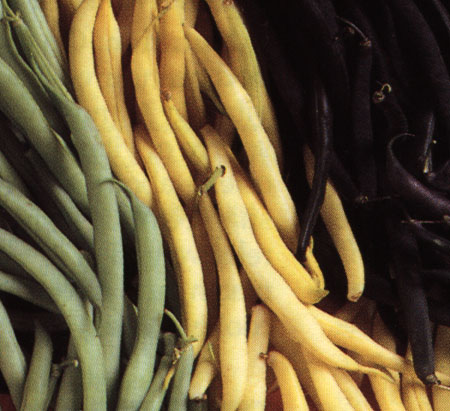
Kentucky Wonder, Romano (Italian)


Chinese Long Beans

FoodFood InformationSidesLegumes
During the winter months the North is supplied with green beans shipped
from Florida, California, and Mexico. During the rest of the year they are
grown locally throughout the country.
These beans are harvested while they are still very young, when the pods,
either flat or round, are tender enough to eat raw and when the inner seed
(also called the bean) has just started to form. They are widely used in
all areas of the country as a fresh, canned, and frozen vegetable.
In most of the nation green beans are known as string beans, dating
back to when most of the varieties had an inedible fibrous string that ran
the length of the bean. In the past fifty years stringed varieties have
disap peered from the marketplace and been replaced by newer varieties in
which these inedible strings have been bred out. In the South, green beans
are known as snap beans, describing what happens when it is bent
in half-it snaps like a twig. If it doesn't snap but just bends without
breaking, it will eat as tough as shoe leather.
The more common varieties of green beans are the round podded types. The
better round varieties include Black Valentines, Blue Lake, Yellow Wax,
Purple, Harvesters, and Contenders. All the round podded varieties
are sometimes called Plentifuls. The flat beans used to be called
Bountifuls but are now known as pole beans. The best of these
is the Kentucky Wonder. While the pole bean varieties are usually much larger
than the round varieties, those of equal quality are equal in tenderness
and flavor. Beans that are yellow in color rather than green are known as
wax beans. There are some green beans that reach a length of eight to twelve
inches. One variety originated in France and is called Haricots Verts.
A very long variety that is highly prized in Oriental cuisine is called
the Chinese long bean (Yard-long beans).
Although we now have better refrigeration and faster transit than we had
twenty-five years ago, today's green beans are seldom as young and tender
as they used to be. This decrease in quality results from the difference
between machine-harvested and hand-picked beans.
Today there is a scarcity of farm labor in the United States, and what is
available is too costly to compete with the machine. Until the 1940s the
vegetable and fruit crops were harvested by migrant workers working for
pitiful wages and under shameful working conditions. Today they are somewhat
protected by federal laws and are paid a minimum wage. Although these wages
are far from sufficient, it is now too costly to hand pick some crops and
migrant workers have been replaced by mechanical picking machines.
These machines are mechanical marvels but are not nearly as selective and
careful as hand labor. The machines can't handle very young beans of the
more fragile but better flavored and more tender varieties without breaking
them. As a result the growers use less tender varieties and don't pick them
until they can withstand the rough handling of the machines. Nearly all
the round beans are now picked by machine. Since the flat pole beans can't
be picked by machine, they very often are more tender than the round varieties.
So even if you have never tried them before, buy pole beans if the round
beans are not up to par.
Identifying tender green or wax beans of top quality is a snap. If
they don't snap, don't buy them. Professional produce buyers determine the
quality of the bean by the way it feels. A young, tender bean wfll have
a pliable, velvety feel. Only buy beans that feel fresh and look colorful.
Avoid those that look or feel coarse and dried out or are discolored.



